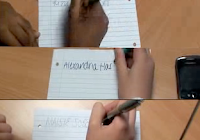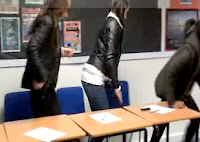Unaccompanied children of any age may watch. A ‘PG’ film should not disturb a child aged around eight or older. However, parents are advised to consider whether the content may upset younger or more sensitive children.
Discriminatory language or behaviour is unlikely to be acceptable unless clearly disapproved of or in an educational or historical context. Discrimination by a character with which children can readily identify is unlikely to be acceptable.
References to illegal drugs or drug misuse must be innocuous or carry a suitable anti-drug message.
Frightening sequences should not be prolonged or intense. Fantasy settings may be a mitigating factor.
No detail of potentially dangerous behaviour which young children are likely to copy. No glamorisation of realistic or easily accessible weapons.
Mild bad language only.
Natural nudity, with no sexual context.
Sexual activity may be implied, but should be discreet and infrequent. Mild sex references and innuendo only.
Where more serious issues are featured (for example, domestic violence) nothing in their treatment should condone unacceptable behaviour.
Moderate violence, without detail, may be allowed, if justified by its context (for example, history, comedy or fantasy).
Suitable for 12 years and over
Exactly the same criteria are used to classify works at ‘12A’ and ‘12’. These categories are awarded where the material is suitable, in general, only for those aged 12 and over. Works classified at these categories may upset children under 12 or contain material which many parents will find unsuitable for them.
The ‘12A’ category exists only for cinema films. No one younger than 12 may see a ‘12A’ film in a cinema unless accompanied by an adult, and films classified ‘12A’ are not recommended for a child below 12. An adult may take a younger child if, in their judgement, the film is suitable for that particular child. In such circumstances, responsibility for allowing a child under 12 to view lies with the accompanying adult.
The ‘12’ category exists only for video works. No one younger than 12 may rent or buy a ‘12’ rated video work.
Discrimination
Discriminatory language or behaviour must not be endorsed by the work as a whole. Aggressive discriminatory language or behaviour is unlikely to be acceptable unless clearly condemned.
Drugs
Any misuse of drugs must be infrequent and should not be glamorised or give instructional detail.
Horror
Moderate physical and psychological threat may be permitted, provided disturbing sequences are not frequent or sustained.
Imitable behaviour
Dangerous behaviour (for example, hanging, suicide and self-harming) should not dwell on detail which could be copied, or appear pain or harm free. Easily accessible weapons should not be glamorised.
Language
Moderate language is allowed. The use of strong language (for example, ‘fuck’) must be infrequent.
Nudity
Nudity is allowed, but in a sexual context must be brief and discreet.
Sex
Sexual activity may be briefly and discreetly portrayed. Sex references should not go beyond what is suitable for young teenagers. Frequent crude references are unlikely to be acceptable.
Theme
Mature themes are acceptable, but their treatment must be suitable for young teenagers.
Violence
Moderate violence is allowed but should not dwell on detail. There should be no emphasis on injuries or blood, but occasional gory moments may be permitted if justified by the context. Sexual violence may only be implied or briefly and discreetly indicated, and must have a strong contextual justification.
 Suitable only for 15 years and over
Suitable only for 15 years and over
No one younger than 15 may see a ‘15’ film in a cinema. No one younger than 15 may rent or buy a ‘15’ rated video work.
Discrimination
The work as a whole must not endorse discriminatory language or behaviour.
Drugs
Drug taking may be shown but the film as a whole must not promote or encourage drug misuse. The misuse of easily accessible and highly dangerous substances (for example, aerosols or solvents) is unlikely to be acceptable.
Horror
Strong threat and menace are permitted unless sadistic or sexualised.
Imitable behaviour
Dangerous behaviour (for example, hanging, suicide and self-harming) should not dwell on detail which could be copied. Easily accessible weapons should not be glamorised.
Language
There may be frequent use of strong language (for example, ‘fuck’). The strongest terms (for example, ‘cunt’) may be acceptable if justified by the context. Aggressive or repeated use of the strongest language is unlikely to be acceptable.
Nudity
Nudity may be allowed in a sexual context but without strong detail. There are no constraints on nudity in a non-sexual or educational context.
Sex
Sexual activity may be portrayed without strong detail. There may be strong verbal references to sexual behaviour, but the strongest references are unlikely to be acceptable unless justified by context. Works whose primary purpose is sexual arousal or stimulation are unlikely to be acceptable.
Theme
No theme is prohibited, provided the treatment is appropriate for 15 year olds.
Violence
Violence may be strong but should not dwell on the infliction of pain or injury. The strongest gory images are unlikely to be acceptable. Strong sadistic or sexualised violence is also unlikely to be acceptable. There may be detailed verbal references to sexual violence but any portrayal of sexual violence must be discreet and have a strong contextual justification.
 Suitable only for adults
Suitable only for adults
No-one younger than 18 may see an ‘18’ film in a cinema.
No-one younger than 18 may rent or buy an ‘18’ rated video.
In line with the consistent findings of the BBFC’s public consultations and The Human Rights Act 1998, at ‘18’ the BBFC’s guideline concerns will not normally override the principle that adults should be free to choose their own entertainment. Exceptions are most likely in the following areas:
- where the material is in breach of the criminal law, or has been created through the commission of a criminal offence
- where material or treatment appears to the BBFC to risk harm to individuals or, through their behaviour, to society – for example, any detailed portrayal of violent or dangerous acts, or of illegal drug use, which may cause harm to public health or morals. This may include portrayals of sexual or sexualised violence which might, for example, eroticise or endorse sexual assault
- where there are more explicit images of sexual activity which cannot be justified by context. Such images may be appropriate in ‘R18’ works, and in ‘sex works’ (see below) would normally be confined to that category.
In the case of video works (including video games), which may be more accessible to younger viewers, intervention may be more frequent than for cinema films.
Sex education at ‘18’
Where sex material genuinely seeks to inform and educate in matters such as human sexuality, safer sex and health, explicit images of sexual activity may be permitted.
Sex works at ‘18’
Sex works are works whose primary purpose is sexual arousal or stimulation. Sex works containing only material which may be simulated are generally passed ‘18’. Sex works containing clear images of real sex, strong fetish material, sexually explicit animated images, or other very strong sexual images will be confined to the ‘R18’ category. Material which is unacceptable in a sex work at ‘R18’ is also unacceptable in a sex work at ‘18’.
 To be shown only in specially licensed cinemas, or supplied only in licensed sex shops, and to adults of not less than 18 years
To be shown only in specially licensed cinemas, or supplied only in licensed sex shops, and to adults of not less than 18 years
The ‘R18’ category is a special and legally restricted classification primarily for explicit works of consenting sex or strong fetish material involving adults. Films may only be shown to adults in specially licensed cinemas, and video works may be supplied to adults only in licensed sex shops. ‘R18’ video works may not be supplied by mail order. The following content is not acceptable:
- any material which is in breach of the criminal law, including material judged to be obscene under the current interpretation of the Obscene Publications Act 1959
- material (including dialogue) likely to encourage an interest in sexually abusive activity (for example, paedophilia, incest or rape) which may include adults role-playing as non-adults
- the portrayal of any sexual activity which involves lack of consent (whether real or simulated). Any form of physical restraint which prevents participants from indicating a withdrawal of consent
- the infliction of pain or acts which may cause lasting physical harm, whether real or (in a sexual context) simulated. Some allowance may be made for moderate, non-abusive, consensual activity
- penetration by any object associated with violence or likely to cause physical harm
- any sexual threats, humiliation or abuse which does not form part of a clearly consenting role-playing game. Strong physical or verbal abuse, even if consensual, is unlikely to be acceptable.
These Guidelines will be applied to the same standard regardless of sexual orientation.
 For our titles we decided that the teacher would write 'featuring' on the board, then we would edit in names of characters afterwards. Our idea would be that the teacher says 'you may begin your lines', and a split screen would show the three girls writing their names and the characters they are playing. For the titles at the beginning, we decided on a simple black screen and white writing showing who edited, filmed and featured in the opening.
For our titles we decided that the teacher would write 'featuring' on the board, then we would edit in names of characters afterwards. Our idea would be that the teacher says 'you may begin your lines', and a split screen would show the three girls writing their names and the characters they are playing. For the titles at the beginning, we decided on a simple black screen and white writing showing who edited, filmed and featured in the opening.  Our genre isn't introduced immediately because we wanted to build suspense. However when the characters receive the text from 'Unknown' saying 'IT'S TIME!', it becomes obvious to the audience that the characters are not the typical school children, and this is where the genre first becomes clear. We then fully establish genre when they run out and the split screen shots show them in fighting poses and our title appears saying 'Teen Spy', which tells the audience what type of film it is going to be.
Our genre isn't introduced immediately because we wanted to build suspense. However when the characters receive the text from 'Unknown' saying 'IT'S TIME!', it becomes obvious to the audience that the characters are not the typical school children, and this is where the genre first becomes clear. We then fully establish genre when they run out and the split screen shots show them in fighting poses and our title appears saying 'Teen Spy', which tells the audience what type of film it is going to be.








